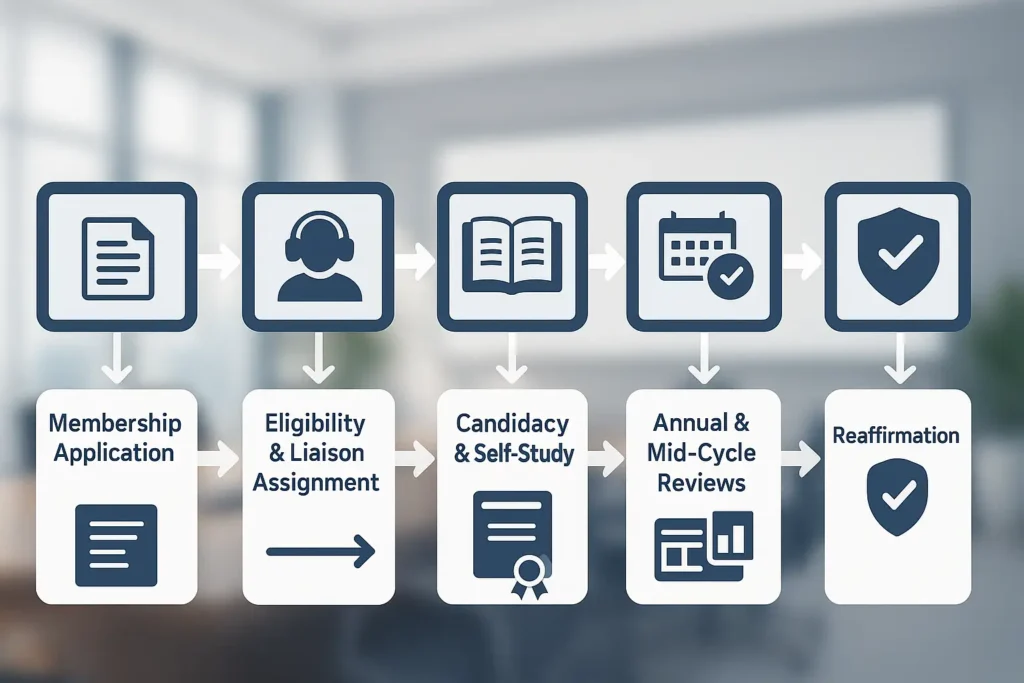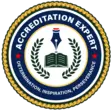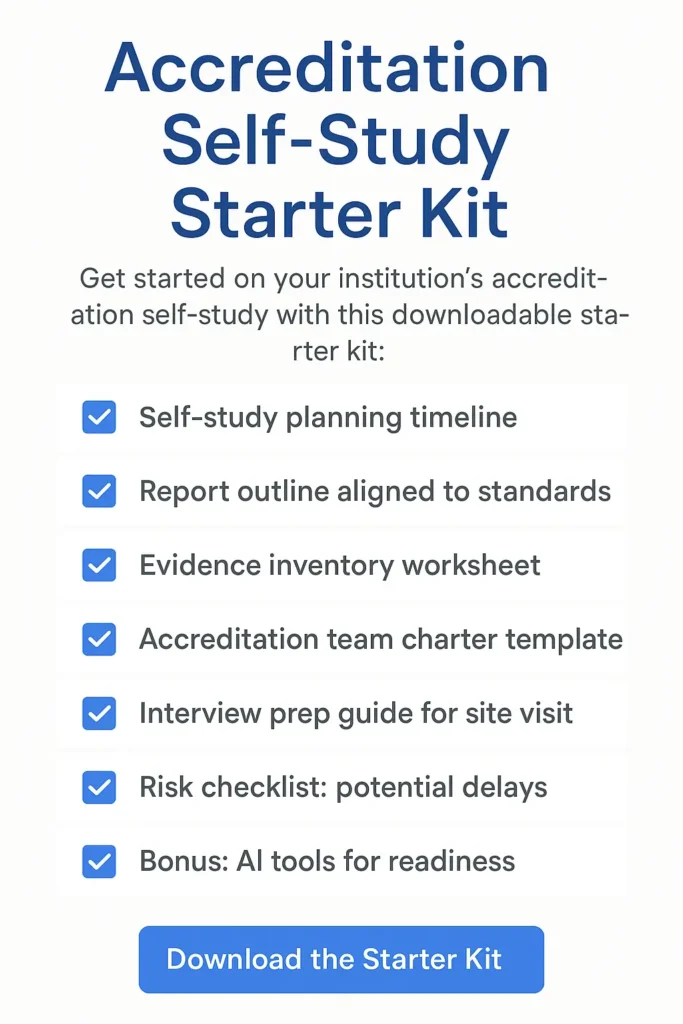
Institutional accreditation is more than a formal seal; it’s a gateway to financial aid, student mobility, and public trust. As 2025 brings increased federal scrutiny, AI-integrated compliance checks, and declining enrollment pressures, colleges and universities must approach accreditation with strategy and structure. This guide lays out how to earn it, keep it, and use it as a foundation for sustainable growth.
What Is Institutional Accreditation and Why Does It Matter in 2025
Institutional accreditation is a third-party quality validation process that enables institutions to access federal financial aid (like Title IV funding), ensure credit transferability, and bolster reputational credibility. Unlike programmatic accreditation, which applies to specific departments (e.g., Nursing, Law), institutional accreditation covers the entire organization.
Following regulatory reforms like the 2019 Negotiated Rulemaking, accreditors are no longer categorized by region but by function. Both institutional and programmatic accreditors must now meet oversight expectations from the U.S. Department of Education and NACIQI (National Advisory Committee on Institutional Quality and Integrity).
Many colleges seek accreditation not only for funding but to remain eligible for military education benefits, articulation agreements, and employer recognition, often turning to Accreditation Approval Support to guide them through the process.

Types of Accrediting Bodies & Standards
the Department of Education, approves institutional accreditors, and each follows its own set of standards.
Examples of Key Accrediting Bodies:
- MSCHE – Middle States Commission on Higher Education
- WSCUC – WASC Senior College and University Commission
- NWCCU – Northwest Commission on Colleges and Universities
- DEAC – Distance Education Accrediting Commission
Each accreditor uses slightly different terminology:
- WSCUC uses CFRs (Criteria for Review)
- MSCHE uses Standards and Criteria
- NWCCU uses Standards and Elements
While specifics vary, common themes include:
- Institutional mission and integrity
- Student achievement and success
- Governance and resource management
- Quality assurance and continuous improvement
You can view the full list of recognized accreditors through the Council for Higher Education
Accreditation (CHEA).
The Accreditation Process: From Membership to Reaffirmation
The first step in the institutional accreditation journey is completing the Membership Application. Institutions must submit detailed documentation that outlines their mission, governance structure, academic programs and courses, and quality assurance measures. These applications typically include 12 to 25 in-depth questions. Once approved, the institution becomes eligible to begin the accreditation process formally.

During the eligibility phase, the accrediting body assigns a liaison, who may be referred to differently depending on the accreditor (e.g., “Chief Administrator” in the Council on Occupational Education). This person serves as the institution’s primary point of contact, guiding leadership through the interpretation of standards, planning documentation, and ensuring candidacy readiness.
Next comes Candidacy, where the institution must compile and submit a complete self-study report, often exceeding 50 pages and including thorough documentation aligned with the accreditor’s standards. A peer review team then visits the campus to validate the findings and interact with staff, faculty, and leadership. Based on this visit, the team submits a recommendation to the accrediting commission. Institutions may then receive one of three outcomes: remain in eligibility status, achieve candidacy, or gain full accreditation.
Initial Accreditation follows successful candidacy. At this stage, institutions must demonstrate that they meet all required standards to transition from candidacy to full accreditation status. Some accreditors may offer a fast-track option, particularly if the institution shows substantial compliance during the first site visit, commonly referred to as SAV-1 (Seeking Accreditation Visit 1).
Once accredited, institutions must continue to report on their progress through Annual Reporting and Mid-Cycle Reviews. These annual submissions provide brief but essential updates on operations, finances, student outcomes, and strategic changes. Around the midpoint of the accreditation cycle (often year three of a six-year cycle), a more in-depth mid-cycle review is required. This may include an updated self-study and sometimes an additional campus visit to ensure the institution remains in compliance.
Finally, Reaffirmation (Reaccreditation) occurs every six to ten years, depending on the accreditor’s cycle. This process resembles initial accreditation but focuses on maintaining compliance rather than establishing it. Institutions must once again submit a self-study, update all supporting documentation, and host a peer review visit. Successful reaffirmation allows institutions to retain their accredited status and continue their participation in federal financial aid programs and credit transfer systems.
Compliance Tips to Stay Accredited in 2025
Staying compliant with accreditation requirements in 2025 demands proactive planning and cross-functional coordination. One of the most critical strategies is to start the self-study (Self-Evaluation) process at least 12 months in advance. This provides adequate time for data collection, internal reviews, and revisions.

Building cross-departmental teams is equally essential. Institutions should include leaders from academic departments, student services, administration, and compliance to ensure a holistic and accurate self-study. Each area brings insights that strengthen the institution’s ability to demonstrate alignment with accreditation standards.
Maintaining accreditation also depends heavily on routine data audits. Institutions should regularly assess and update outcomes data, program reviews, assessment reports, board meeting minutes, and organizational charts. This ensures that all documentation is both accurate and accessible when needed.
Clear and transparent communication with internal stakeholders and the accrediting agency is vital. Keeping leadership, faculty, and staff informed on accreditation status, timelines, and responsibilities helps foster buy-in and reduces the risk of missed deliverables.
Finally, when navigating complex documentation, leadership transitions, or self-study development, many institutions benefit from working with professional accreditation consultants. Engaging institutional accreditation consultants can accelerate readiness, ensure compliance, and reduce stress throughout the process.
Common Accreditation Pitfalls — And How to Avoid Them

1-Starting the self-study (self-evaluation) too late
Many institutions face setbacks during the accreditation process because of avoidable mistakes. One of the most frequent missteps is starting the self-study (self-evaluation) too late. Institutions often underestimate the time required to gather, analyze, and compile documentation that aligns with accreditor standards. Beginning the process early, ideally 12 months in advance, provides the necessary lead time to coordinate contributions across departments and respond to gaps.
2-Submitting outdated assessment data
Another common issue is submitting outdated assessment data. Accreditors expect current, evidence-based documentation of student learning outcomes, program reviews, and institutional effectiveness. Submitting data that is more than a year old or incomplete can lead to delays or denials in candidacy or reaffirmation.
3-Weak board governance documentation
Weak board governance documentation is also a red flag for accreditors. Institutions must demonstrate that their governing board operates independently, understands its fiduciary responsibilities, and follows established bylaws and policies. Failure to provide meeting minutes, conflict-of-interest policies, or evaluations of board effectiveness can raise questions about governance.
4-Poor preparation for site visit interviews
Preparation for the accreditation site visit is another area where institutions often fall short. Faculty, staff, and leadership must be briefed and rehearsed in advance of the peer review team’s visit. Poor interview performance, inconsistent answers, or confusion about processes can raise credibility concerns, even if documentation is strong.
5-Failing to address previously flagged issues
Lastly, institutions that have previously received recommendations or warnings but fail to fully address flagged issues place themselves at risk for probation or more serious sanctions. Accreditors expect a clear and measurable response to past concerns. Demonstrating action plans, timelines, and outcomes tied to those issues is essential to moving forward.
Avoiding these pitfalls begins with strong internal communication, data management, and early planning—and when needed, expert guidance from accreditation support consultants who understand how to navigate complexity without compromising integrity.
Real Example:
Trident University was placed on Show Cause for graduating students without required credits and not reporting it, highlighting how internal compliance breakdowns can lead to a crisis.
Checklist: Is Your Institution Accreditation-Ready?
☐ Is your last self-study less than 12 months old?
☐ Are student learning outcomes current and measurable?
☐ Has your board reviewed accreditation metrics this year?
☐ Do you have a clear plan for mid-cycle review prep?
☐ Are program assessment reports stored centrally and updated?
☐ Is your compliance team meeting quarterly?
Frequently Asked Questions (FAQs)
Why is institutional accreditation important in 2025?
It determines access to Title IV aid, credit recognition, and public trust now under tighter regulation.
What’s the difference between institutional and programmatic accreditation?
Institutional covers the whole college; programmatic covers specific departments.
How long does accreditation last?
Typically 6–10 years, depending on the accreditor.
What triggers probation or sanctions?
Non-compliance with standards, especially governance, academic quality, and transparency.
What’s the timeline from eligibility to accreditation?
Usually 2–5 years, depending on readiness and the accreditor process.
AEC Note
Institutional accreditation isn’t just about funding, it’s about future-proofing your institution. With evolving compliance requirements and AI-enhanced reporting standards, 2025 demands a proactive, informed approach.
Schedule your free Accreditation Readiness Review.
Download our Accreditation Self-Study Starter Kit





